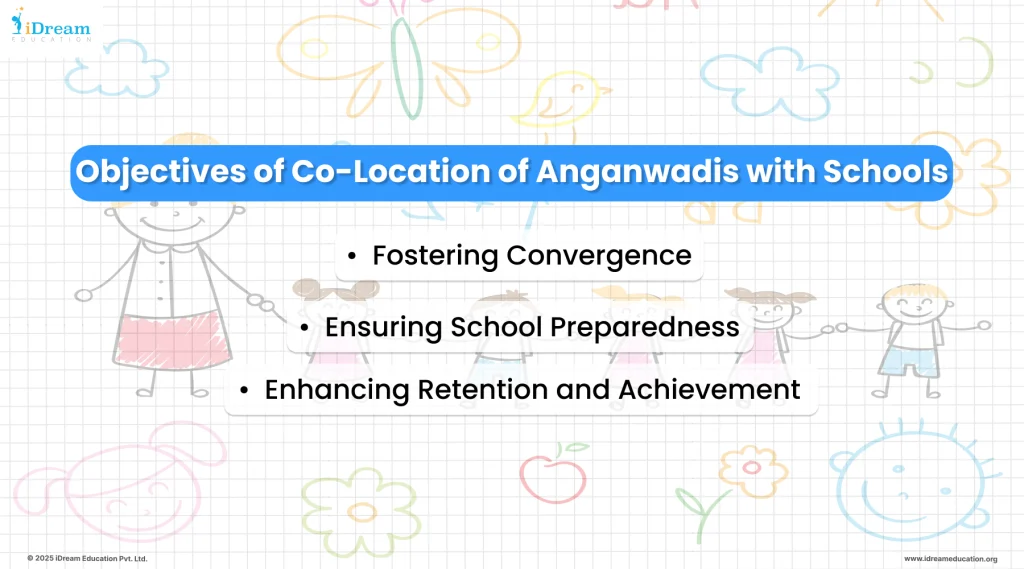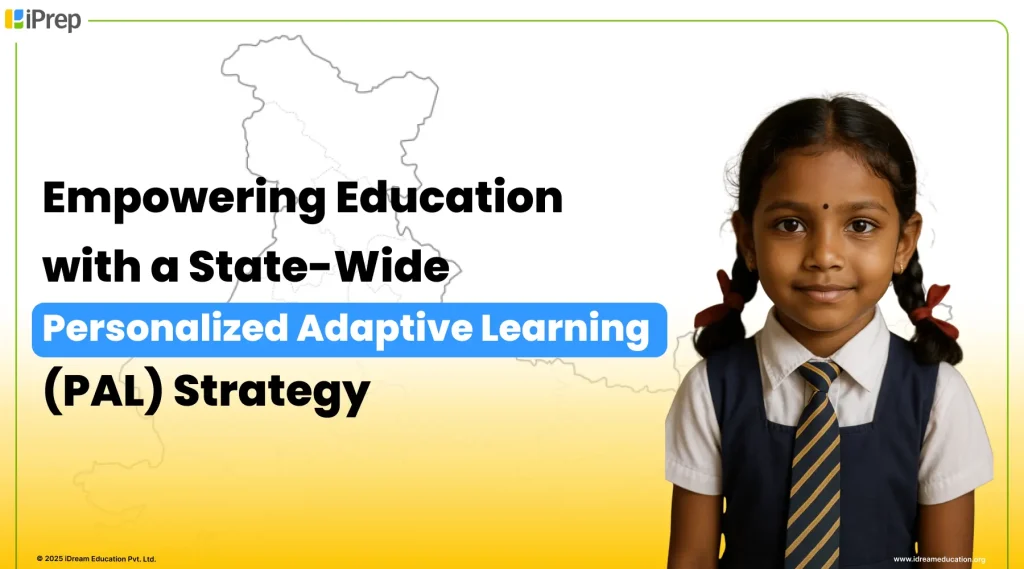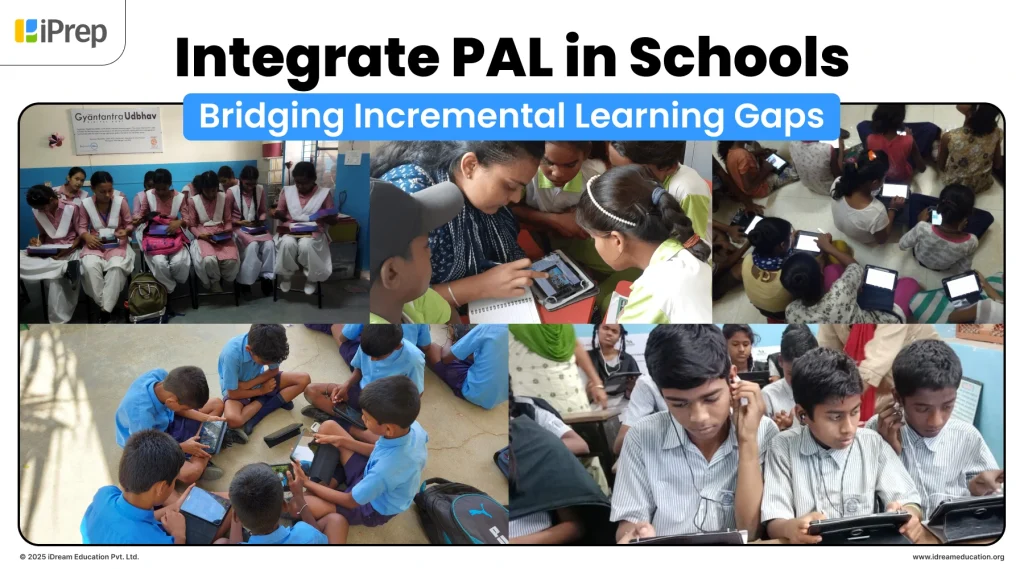
On 3rd September 2025, the Ministry of Women and Child Development released new guidelines for the co-location of Anganwadi Centres (AWCs) with schools. Under this framework, co-locating Anganwadis with primary schools has emerged as a practical and forward-looking strategy. It is launched to strengthen early childhood education in India.
With over 14.02 lakh Anganwadi Centres across the country of which 2.9 lakh are already co-located with schools – the scale of this initiative is significant. At the same time, it underscores the need for common standards, clear operational norms, and coordinated efforts to maximize the impact of early learning programs.
Who Prepared the Guidelines for Co-Location of Anganwadis with Schools?
These guidelines have been jointly prepared by the Ministry of Women and Child Development (MoWCD) and the Department of School Education & Literacy (DoSE&L). The Co-Location guidelines reflect a collaborative approach to integrate early childhood care with formal schooling and provide States & UTs a roadmap to strengthen co-location procedures.
About Launch Event of Co-Location Guidelines
The launch event at Vigyan Bhawan, New Delhi was graced by Union Minister for Women and Child Development, Smt. Annpurna Devi, and Union Minister for Education, Shri Dharmendra Pradhan. Senior officials from MoWCD and MoE, representatives from States and UTs, and Anganwadi workers attended the event. This highlights a collaborative effort to strengthen early childhood and school education integration.
Sharing these updates on the Guidelines, Smt. Annpurna Devi Ji stated that,
“The co-location of Anganwadis with schools will ensure a smooth transition from early childhood care to formal schooling and contribute to the holistic development of children.”
She further added that,
“The guidelines will serve as an important roadmap for States and UTs to scale up this integrated model and fulfill the vision of the Prime Minister for a healthy, educated, and empowered young generation.”
Union Minister for Education, Shri Dharmendra Pradhan Ji, in his address, emphasized that,
“Early Childhood Education forms the bedrock of lifelong learning. By integrating Anganwadis with schools, we are creating a seamless and enabling learning environment from the very beginning. This joint effort of the MoWCD and MoE will not only strengthen foundational literacy and numeracy but also play a vital role in nurturing India’s human capital to achieve the goal of a Viksit Bharat.”
Watch the full video of the launch of the Guidelines for Co-location of Anganwadi Centres with Schools
Let us Look at the Focus of Co-Location of Anganwadis with Schools
The Co-Location of Anganwadis with Schools guidelines emphasize establishing clear standards for effective integration between pre-school and primary education. At its core, the focus is on fostering convergence between Anganwadi Workers (AWWs) and school teachers through joint planning, curriculum alignment, and coordinated activities. This collaboration ensures that children experience a seamless transition from Anganwadi to Grade 1. This will further reduce the risk of dropouts and supporting stronger foundational learning outcomes.
Additionally, the guidelines highlight the importance of engaging parents in the learning journey and creating child-friendly environments that stimulate holistic development. By institutionalizing these practices, States and Union Territories can improve educational continuity. They can also strengthen the overall ecosystem of early childhood education. This ensures that every child receives the support needed for a confident start in school.
What Are the Objectives of Co-Location of Anganwadis with Schools?

The co-location initiative aims to strengthen the bridge between early childhood and primary education. Its key objectives include:
Ensuring School Preparedness
This is to support a smooth transition for children from Anganwadi Centres (AWCs) to Grade 1, so they are ready to thrive in primary school.
Fostering Convergence
This is to create strong linkages between AWCs and primary schools to provide joyful learning experiences and a stimulating environment, promoting holistic development.
Enhancing Retention and Achievement
This is to reduce dropout rates at the primary level and laying the foundation for higher learning outcomes across various stages of education.
By focusing on these objectives, co-location will help build a cohesive early learning ecosystem where children can progress confidently and successfully.
Co-Location Guidelines Also Mention Early Childhood Care and Education (ECCE) in India as a Unified Vision
The guidelines on Co-Location of Anganwadis with Schools align closely with India’s Unified Vision for Early Childhood Care and Education (ECCE). This vision, first articulated in the National ECCE Policy 2013, emphasized the need to ensure quality early childhood care and education for every child below six years of age across the country.
Building on this, the National Education Policy (NEP) 2020 introduced the 5+3+3+4 curricular structure, with the Foundational Stage (ages 3–8) combining three years of pre-school (ages 3–6) and Grades 1 and 2 (ages 6–8). This structure ensures a seamless continuum of learning from early years into primary education. The guidelines reinforce this vision by promoting co-location of Anganwadis with schools, thereby enabling universal access to high-quality ECCE through multiple pathways:
- Standalone Anganwadis
- Anganwadis co-located with primary schools
- Pre-primary sections (for ages 5–6) within existing primary schools
- Standalone pre-schools
Together, these policies and guidelines represent a unified national effort to integrate care, learning, and development during the most critical years of a child’s growth. This lays a strong foundation for lifelong learning and holistic development.
Now Let us Know Why Does Co-Location Matter?
The Co-Location Guidelines offer multiple benefits for Anganwadi children, ensuring they experience a smoother, more holistic transition into formal schooling:
Seamless Transition into the Foundational Stage
In the 5+3+3+4 curricular structure, the first three years of pre-primary focus on playful learning, while Classes 1–2 build Foundational Literacy & Numeracy (FLN). With co-location, children would gain early exposure to structured learning, so by the time they enter Grade 1, they are already prepared with the right FLN skills. This will ensure a smoother and more confident progression into the preparatory stage.
Curriculum Alignment
The convergence between Anganwadi Workers (AWWs) and school teachers through joint planning, curriculum alignment, and coordinated activities, Anganwadis can closely follow NCF-FS, age-appropriate competencies, and NIPUN Bharat goals. This would be further strengthened by the introduction of the Adhaarshila Curriculum, Jaadui Pitara, and e-Jaadui Pitara. Anganwadi Workers will now have a structured teaching framework that aligns seamlessly with school-level learning standards.
Peer and Cross-Learning Opportunities
Sharing space with primary schools will enable interaction among children and workers from different age groups. This will promote cross-learning, peer-to-peer support, and structured social development, as they observe and learn from each other in a shared environment.
Continuity in Learning and Inspiration
The formal school environment will inspire Anganwadi Workers to adopt more structured teaching practices, while the playful, nurturing approach of Anganwadis will enrich early grade classrooms. This two-way exchange strengthens the foundational stage experience.
Smoother Transition to Schooling
When children move from Anganwadi centres to formal schools, the environment will not be alien to them. This reduces resistance, builds comfort, and encourages smoother transition. Over time, this will support higher attendance and retention.
Through co-location, children gain a well-rounded, continuous learning experience that bridges early childhood education with primary schooling, supporting both academic and social development.
To further accelerate the vision of co-locating Anganwadis with schools, we need a unified digital initiative
With over nine years of hands-on experience working with schools, we recognize that the vision of co-locating Anganwadis with primary schools can be significantly strengthened through a unified digital initiative. By establishing common digital classrooms and libraries, children from both Anganwadi centres and schools can learn together in a technology-enabled, engaging environment. This shared space encourages peer-to-peer learning, meaningful interactions, and stronger connections among children and workers alike.
Co-location also addresses a key gap in previous Anganwadi initiatives: the lack of accountability and data-driven tracking of teaching and learning outcomes. When Anganwadis operate alongside schools, they can leverage existing infrastructure and digital resources to monitor, record, and enhance the use of digital and experiential learning tools, ensuring that every learning activity is measurable and impactful.
Additionally, these digital resources, when set up in a shared environment, would offer flexible and scalable use that benefits both Anganwadis and schools independently, while fostering inclusive learning opportunities. By combining co-location with technology-enabled learning, this approach brings the vision of a holistic, measurable, and inclusive early learning ecosystem closer to reality, preparing every child for a confident, joyful start to formal schooling.
The co-location of Anganwadi centres with schools presents a powerful opportunity to ensure that every child begins their educational journey with equal confidence and capability.
At iDream Education, we remain committed to partnering with governments, NGOs, and consultants to strengthen digital learning ecosystems in both schools and Anganwadis, ensuring that all initiatives are aligned with NEP, NCF, and NCERT standards. Together, this approach can lay the foundation for a holistic and future-ready education for every child.
To learn how we can support and help you strengthen the vision of co-locating Anganwadis with schools and achieve its objectives, you may contact us at +91 7678265039. You can also write to us share@idreameducation.org or share your details here
Frequently Asked Questions -
1. What is the new co-location guideline for Anganwadi Centres?
On 3rd September 2025, the Ministry of Women and Child Development released new guidelines for the co-location of Anganwadi Centres (AWCs) with schools. Under this framework, co-locating Anganwadis with primary schools has emerged as a practical and forward-looking strategy to strengthen early childhood education in India.
2. Why is co-location of Anganwadi’s with Schools important?
It helps children aged 3–6 smoothly transition into primary school and ensures better access to learning and play-based resources.
3. How many Anganwadi Centres are currently co-located with schools?
Out of 14.02 lakh AWCs, around 2.9 lakh are already co-located with primary schools.
4. What issues do the new co-location guidelines aim to solve?
They introduce common standards, clearer operational norms, and better coordination between Anganwadi workers and school teachers.
5. What Are the Objectives of Co-Location of Anganwadis with Schools?
Ensuring School Preparedness Fostering Convergence Enhancing Retention and Achievement
6. How do the new co-location guidelines relate to India’s ECCE vision?
The guidelines support India’s Unified ECCE Vision by ensuring smoother integration of Anganwadi Centres with primary schools, strengthening early childhood care and education.
7. What are the different pathways through which ECCE can be delivered under the Co-location guidelines?
Standalone Anganwadis Anganwadis co-located with primary schools Pre-primary sections in schools Standalone pre-schools
8. How do these Co-Location of Anganwadis with Schools guidelines contribute to long-term learning?
By aligning ECCE, co-location, and NEP 2020, the guidelines strengthen the foundation for lifelong learning and holistic development during the most critical early years.












